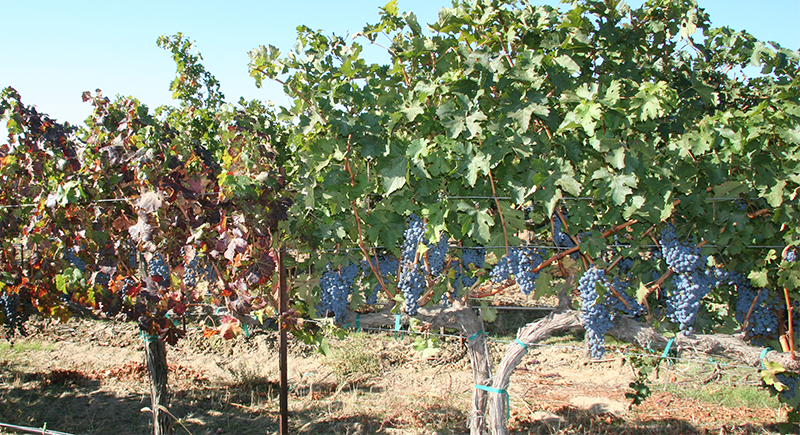
May 9, 2016 Study compares wines from diseased and healthy vines

By Scott Weybright, College of Agricultural, Human & Natural Resource Sciences
PROSSER, Wash. – Grapevine leafroll disease (GLD) has plagued vineyards for centuries, but little is known about how this virus impacts the fruit quality and actual wine produced from grapes of affected plants.
Researchers from different disciplines at Washington State University teamed up to examine virus impacts from “vine to wine.” Their study, recently published in PLoS ONE, can be found at http://dx.doi.org/10.1371/journal.pone.0149666.
Three years of wine comparisons
They made wines from red grapes from vines with GLD and wines from healthy plants to learn the effects of GLD on wine chemistry.
“In most studies we do, we use a limited number of grapes for data collection,” said Naidu Rayapati, a WSU virologist and associate professor of plant pathology. “This time, we harvested 750 to 800 pounds from infected vines and an equal number from healthy vines, all donated by a generous grower.”
The grapes were harvested at different points in the season to measure whether early or late harvesting made the GLD more of a factor in the finished wine. They replicated the tests over three years to allow for changes from warm years versus cooler years.
Warm years see smaller differences
In the final results, wines from GLD-affected grapes had significantly lower alcohol, polymeric pigments and anthocyanins (both are coloring agents in wine) compared to corresponding wines from grapes of non-symptomatic vines.
The impacts wound up being more pronounced during cooler growing seasons than in warmer seasons.
“We think that’s because grapes mature much faster in warmer seasons and don’t have as much time to be affected by the virus,” Rayapati said.
That’s just a hypothesis at this point, he said, and he hopes to do more research into seasonal influences for a deeper understanding of how GLD impacts vine health and fruit and wine quality. He aims to translate this knowledge for practical applications in vineyards.
Unusual collaboration
Rayapati worked on this study with colleagues Olufemi Alabi, Federico Casassa, Linga Gutha, Richard Larsen, Thomas Henick-Kling and Jim Harbertson. Harbertson and Henick-Kling are with the wine program at WSU Tri-Cities in Richland, Wash.
Harbertson and Rayapati agreed that it is unique for the two sides of winemaking, the viticulturists like Rayapati and the enologists like Harbertson, to collaborate on a project. Mostly, that’s because it’s difficult to get the amount of grapes of any affected plant needed to make wine.
Harbertson cautioned that it’s unlikely a vintner would ever make a wine with grapes from 100 percent GLD-affected vines. But he said this research helps show that a virus can impact more than just the amount of grapes produced and harvested.
Contacts:
Naidu Rayapati, WSU plant pathology, 509-786-9215, naidu@wsu.edu
James Harbertson, WSU viticulture and enology, 509-372-7506, jfharbertson@wsu.edu




